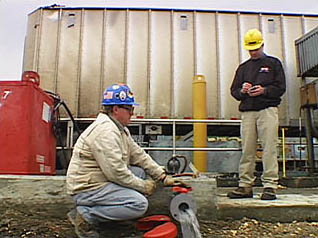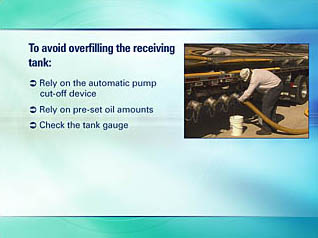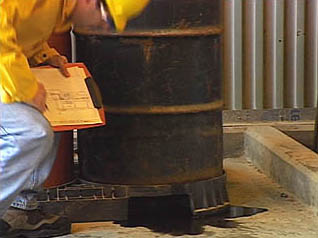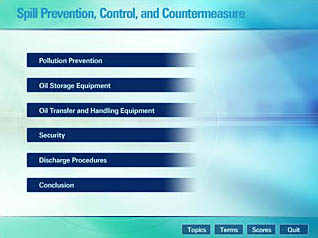Spill Prevention, Control, and Countermeasure (SPCC)
- Product ID
- evisspcc
- Training Time ?
- 63 to 126 minutes
- Language(s)
- English
- Video Format
- Standard Definition
- Required Plugins
- MasteryNet Player
- Lesson Interactions
- 15
- Quiz Questions
- 23
- Closed Captioning



This SPCC training course uses high quality video to teach spill prevention. In this spill prevention training course, your workers will learn about SPCC plans, pollution regulations, proper storage of oil, and oil transfer procedures. This SPCC training course teaches proper containment practices including secondary containment. Workers will also learn to avoid security breaches and follow proper discharge procedures in this SPCC training course.
![]() This course is in the Advantage™ format, to read about Advantage™ features click here.
This course is in the Advantage™ format, to read about Advantage™ features click here.



- Install on any SCORM LMS
- Rich multimedia presentation with interactions and quiz
- Print certificate and wallet card
- You have 30 days to complete the course
All employees at facilities with the capacity to store or handle in excess of 1320 gallons of any oil or oil product (gasoline, heating oil, lubricants, residual fuels, vegetable and animal oils and other oils).
-
Pollution Prevention
- Pollution regulations
- The SPPC plan
- The key to spill prevention
-
Oil Storage Equipment
- The secondary containment structure
- Secondary containment failures
- Secondary containment drain mechanisms
- Oil and water accumulation
- Conditions to report
-
Oil Transfer and Handling Equipment
- Before the transfer
- During the transfer
- Additional equipment procedures
-
Security
- Common security features
- Suspicious situations
-
Discharge Procedure Protocols
- Signs of trouble
- First person on the scene
- Spill information
-
Use the SPCC plan to prevent pollution from spills.
- Explain the reason for an SPCC plan.
- Identify the conditions under which a facility is required to have an SPCC Plan.
- List contents of the SPCC plan.
- Recognize the key to oil spill prevention.
-
Follow proper containment practices for oil storage equipment.
- Define secondary containment.
- Identify the necessary size of a containment structure.
- List causes of secondary containment structure failures.
- Describe the proper position of a secondary containment structure's drain valve.
- Explain the importance of limiting the amount of rain water or debris in secondary containment structures.
- Select the conditions for draining secondary containment structures.
- Clarify the proper procedure if you see a small accumulation of oil below an oil pump inside a secondary containment structure.
- List problem conditions that should be reported.
-
Properly operate oil transfer and handling equipment.
- List actions to take prior to the transfer operation.
- State the distance the driver should stay within during fuel transfer.
- Identify when accidents involving oil are most likely to occur.
- Explain what to do with inactive hoses and pipelines.
- Identify the need to perform, record, and file alarm tests on a regular basis.
-
Follow proper safety procedures to avoid security breaches.
- List common facility security features.
- Recall the procedure to follow if a suspicious package is observed.
- State the procedure to follow if a stranger is observed.
-
Follow proper discharge procedures.
- Identify incidents requiring shutdown of oil transfer operations.
- Recall the first step to take when an oil leak or release is discovered.
- Agree to never act as the First Responder without proper training.
© Mastery Technologies, Inc.




